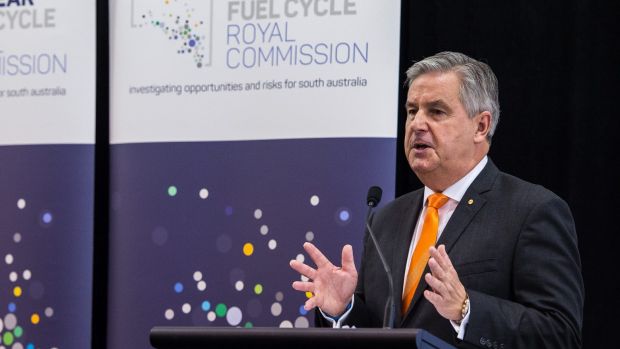Building a sophisticated underground nuclear waste storage facility could cost up to $33 billion and would need a substantial commitment from foreign customers before it could be built, nuclear inquiry royal commissioner Kevin Scarce said.
Contracts to store about 15,500 tonnes of spent nuclear fuel rods would need to be signed for the project to start and revenue from an interim above-ground storage facility would help for the first 10 years, said Mr Scarce, who heard from 128 witnesses during the Nuclear Fuel Cycle Royal Commission hearings.

Support for the proposal is slowly building. Federal Opposition Leader Bill Shorten said he would support the concept if several conditions were met. Federal Resources and Energy Minister Josh Frydenberg said in Canberra while it would be difficult to build a community consensus to ensure the project went ahead, the federal government was unlikely to stand in its way if South Australia wanted it.
"If the South Australian people and the South Australian government were to go down the path of bringing in high-level waste, it would be a brave federal government that stood in its way," Mr Frydenberg said at the National Press Club in Canberra.
Mr Shorten told reporters in Adelaide there needed to be an economic benefit demonstrated and it needed to meet all environmental concerns and "that there is community support". It was a significant softening of Mr Shorten's previous hardline anti-nuclear stance.
Mr Scarce said there needed to be federal and state government backing for the project but upfront commitments would be crucial because of the vast cost.
Local opinion
"That's the first part of the puzzle," Mr Scarce said on Tuesday as he headed to the northern South Australian regional city of Port Pirie for a public meeting where locals will be able to have their say on the proposal.
Similar meetings were held on Monday night in Adelaide with more planned over the next five weeks during a consultation period, before a final report is released on May 6.
An interim above-ground storage facility with access to a port and railway could be built for $2 billion-plus, but the capital cost of a sophisticated underground facility up to 500 metres below ground was estimated at $33.4 billion by the royal commission in its preliminary findings on Monday.
It outlined that $257 billion could be generated from a nuclear waste storage and disposal facility over 120 years, with total costs estimated at $145 billion. It recommended against setting up a nuclear power plant in South Australia because the market dynamics did not make it commercially viable although nuclear power needed to be closely examined on the national stage for the country's future energy needs.
Mr Scarce said on Tuesday the royal commission had crunched its numbers using a baseline price of $1.75 million per tonne of spent fuel. The state would need to secure forward contracts for 15,500 tonnes of spent fuel for the business case of a minimum-scale facility to stack up.
He said a full-scale facility deep underground would be expensive and because of the long-term nature of the proposal, the facility would need to be owned by the state and federal government. But a private operator could be brought in to run it.
Costs would reduce as throughput increased.
"Obviously when you're already down that deep the additional cost is not as significant," he said.
Stable geology
Mr Scarce said the stable geology of South Australia lent itself to an underground storage facility, and it did not necessarily need to be located in desert lands in the far north of the state.
"There's lots of stable geology in South Australia," he said.
The total capital cost of constructing, decommissioning and then closing the facilities at the end of the 120-year life has been estimated at $41 billion by consultants Jacobs MCM, one of the specialist firms used by the royal commission, which took evidence from 128 witnesses over 12 months.
The federal government has a separate process underway where six sites have been identified as having potential to host a low-level radioactive waste storage facility. South Australian Premier Jay Weatherill said on Monday he thought two sites – one for low-level radioactive waste and the other a much bigger storage facility – could co-exist but there was a long way to go before final decisions would be made and the "costs and benefits" would be weighed up by the community.












 powered by plista
powered by plista








